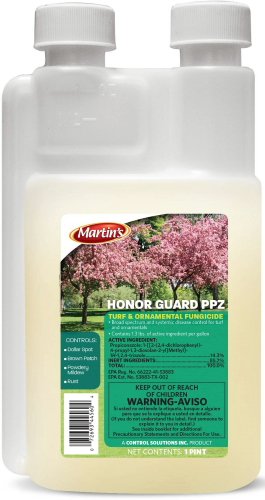If you’re looking for the best fungicide to keep your St. Augustine grass healthy, it’s important to consider a few factors before making a purchase. St. Augustine grass is prone to developing fungal diseases, which can cause serious damage if left untreated. Fortunately, there are several fungicides available on the market that can help prevent and control these diseases.
When choosing a fungicide for your St. Augustine grass, it’s important to consider the severity of the disease, the type of fungus involved, and the formulation of the product. Some fungicides are designed to prevent fungal diseases, while others are more suited for treating active infections. Additionally, certain types of fungi may require specific fungicide formulations for effective control.
To ensure that you choose the best fungicide for your St. Augustine grass, take some time to research your options and consider the specific needs of your lawn. Look for products that are labeled for use on St. Augustine grass and that have a good track record of effectiveness. Additionally, be sure to follow all application instructions carefully to ensure that you apply the product correctly and safely.
Are you struggling to keep your St. Augustine grass healthy? Do you notice patches of brown or yellow grass in your lawn? Are you worried that your lawn has been infected with a fungal disease? If so, it’s important to act quickly to prevent further damage. By choosing the best fungicide for your St. Augustine grass and applying it correctly, you can help protect your lawn and keep it looking healthy and beautiful all year long.
10 Best Fungicide For St Augustine Grass
| # | Product Image | Product Name | Product Notes | Check Price |
|---|---|---|---|---|
|
1
|
It is ideal for controlling fungal diseases in organic gardening.
|
|
||
|
2
|
It is ideal for preventing and treating fungal diseases in lawns caused by weather conditions like humidity, heat, and rain.
|
|
||
|
3
|
The product is ideal for controlling fungal diseases in gardens and is organic.
|
|
||
|
4
|
The product is ideal for controlling diseases in roses, flowers, and shrubs.
|
|
||
|
5
|
It is ideal for preventing and treating fungal diseases on plants.
|
|
||
|
6
|
This product is ideal for controlling and preventing plant diseases caused by fungi.
|
|
||
|
7
|
The product is ideal for repairing St. Augustine lawns with a combination of mulch and fertilizer.
|
|
||
|
8
|
It is an ideal product for controlling common diseases in lawns and gardens with its organic gardening formulation.
|
|
||
|
9
|
The product is ideal for controlling and preventing fungal diseases in various crops.
|
|
||
|
10
|
It is a broad spectrum fungicide ideal for controlling various fungal diseases in turfgrass, ornamentals, and trees.
|
|
1. Organic Grow Inc 7004 32 Oz Rts 3 Controls Organic Fungicide
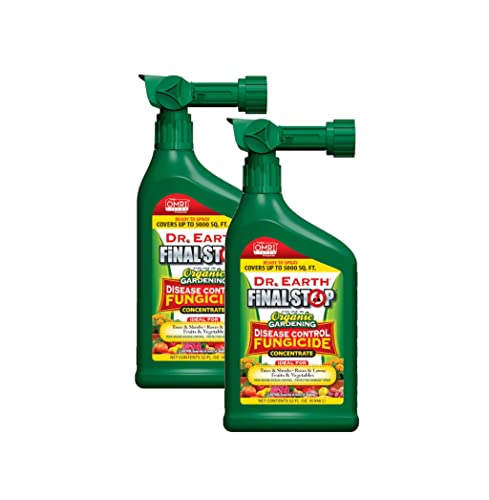
This pack of 2 organic botanical fungicides is a gardener's dream come true. The ultra-premium scientific formula is designed to provide optimum levels of killing power to control diseases, molds, and fungi on vegetables, fruit trees, roses, turf, ornamentals, trees, and shrubs in every part of the yard and garden.
The active ingredients include rosemary oil, cloves and clove oil, peppermint oil, and malic acid, which work synergistically to eliminate and prevent the growth of harmful pathogens. This broad-spectrum fungicide is formulated with multi-minerals that help heal disease-damaged foliage, promoting healthy plant growth and vitality.
Gardeners will appreciate the ease and convenience of using this fungicide, which can be applied with a sprayer or watering can. The formula is safe to use around pets and children, making it an ideal choice for families who love to spend time outdoors.
2. Fertilome (12770) F-Stop Fungicide Granules (10 Lb.)
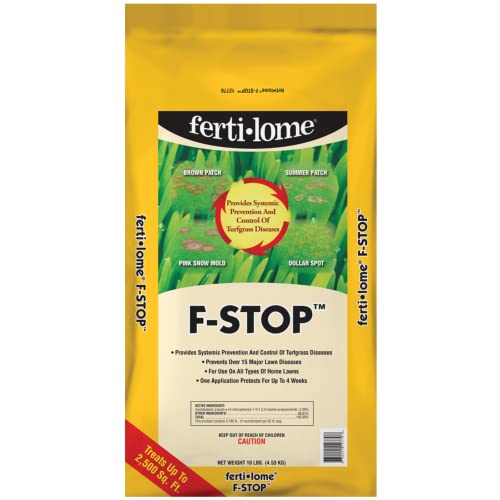
The F-Stop Fungicide Granules are a reliable and effective solution for controlling and preventing turfgrass diseases. This systemic fungicide provides both curative and protective measures, ensuring versatile coverage against over 15 types of diseases. The complete list of diseases can be found on the label for reference.
With just a single application, the F-Stop Fungicide Granules can protect your lawn for up to 4 weeks. This makes it a convenient and time-saving option for lawn care enthusiasts. Each 10lb bag of fungicide can treat up to 2,500 square feet of lawn, landscapes, or golf courses, making it an ideal choice for both residential and commercial applications.
To apply the F-Stop Fungicide Granules, simply use a drop or rotary spreader over the turfgrass area. The label provides detailed instructions on recommended application rates for optimal results. By following the instructions, you can easily and effectively protect your lawn from harmful diseases.
3. Root 98 Warehouse Southern Ag Garden Friendly Bio Fungicide Organic, 8 Oz
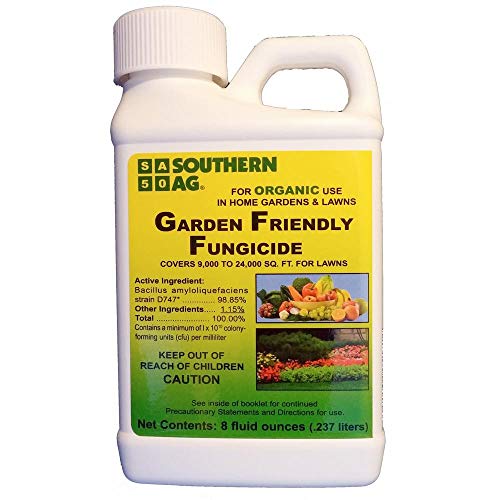
This potent 8 oz biofungicide/bactericide is a must-have for all home gardeners. It is specially designed to control plant diseases in a wide variety of plants, including vegetables, ornamental and fruit trees, shrubs, lawns, flowers, bedding plants, and potted ornamental plants.
This powerful formula contains 98.85% Bacillus amyloliquefaciens strain D747*, which is a highly effective and safe ingredient for controlling plant diseases. It is an excellent alternative to harmful chemicals and pesticides.
This product is suitable for both small and large-scale gardening, and it is easy to use. Simply follow the instructions on the label and apply as needed.
If you're interested in purchasing this biofungicide/bactericide in bulk or would like to request a mixed multi-pack, please send a message to the seller for large quantity discount consideration.
4. Bioadvanced Disease Control For Roses, Flowers And Shrubs, Concentrate, 32 Oz
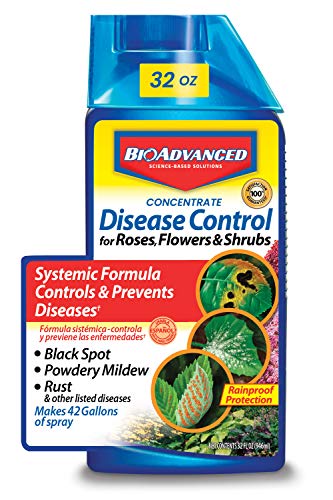
The Systemic Formula is a highly effective solution in curing and preventing diseases in various plants such as roses, flowers, shrubs, and houseplants. This product is formulated to control a wide range of diseases including Black Spot, Powdery Mildew, Crabapple Scab, Boxwood Blight, and many more.
One of the key benefits of this product is its rainproof protection that can last up to 2 weeks, making it ideal for outdoor plants that are frequently exposed to harsh weather conditions. With its systemic formula, this fungicide can be absorbed by the plants and spread throughout the entire system, providing long-lasting protection against diseases.
This product is also very economical as it can make up to 42 gallons of spray, providing ample coverage for a wide range of plants. It is important to note that this product is not for sale in NY due to certain restrictions.
5. Bonide Products 775 Ready-To-Use Copper Fungicide, 32-Ounce [2-Pack]
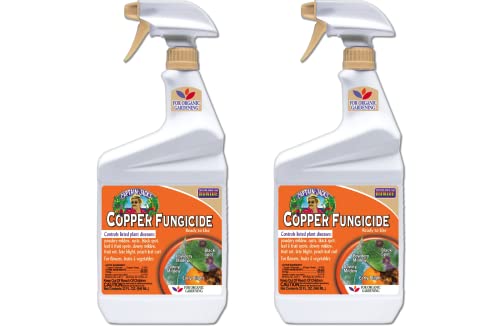
This 2-pack of 32 oz (64 oz in total) Copper Fungicide is an effective solution for preventing fungal growth on your plants. The ready-to-use formula is convenient and easy to apply, making it ideal for both novice and experienced gardeners.
Copper Fungicide is a broad-spectrum fungicide that works by disrupting the metabolic processes of disease-causing fungi, preventing them from growing and spreading. The active ingredient in this product is copper octanoate, a naturally occurring compound that is safe for use on a variety of plants, including vegetables, fruits, and ornamentals.
The 32 oz spray bottle is ergonomically designed for easy handling and precise application. Simply spray the product onto your plants, making sure to cover the entire surface of the leaves. The fungicide will adhere to the plant, creating a protective barrier that will prevent fungal spores from germinating.
This fungicide is effective against a wide range of fungal diseases, including powdery mildew, black spot, and rust. It is also effective at preventing the spread of bacterial blight and other plant diseases.
This 2-pack of 32 oz Copper Fungicide is a cost-effective solution for preventing fungal growth on your plants. The product is safe for use around people and pets when used according to the label instructions, and it will not harm beneficial insects such as bees and ladybugs.
6. Monterey Agri-Fos Disease Control Fungicide – Pint Lg3340
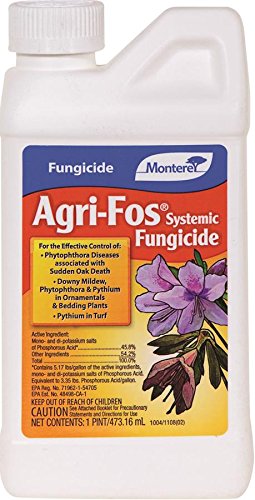
Looking for a versatile and reliable solution to take care of your plants? Look no further than these high-quality planters! Made in the United States with the utmost attention to detail and quality, these planters are designed to offer exceptional performance and durability, no matter what your needs may be.
One of the key advantages of these planters is their versatility. Depending on your specific usage needs, you can apply them in a variety of different ways. Use them as a foliar spray, a soil drench, a soil incorporation, a basal bark treatment, or even a bare root dip! This makes them an ideal choice for a wide range of different plants and growing environments, ensuring that you can always find a way to get the best possible results.
Of course, it's not just about versatility – these planters are also built to last. Made from high-quality materials and with a focus on durability and performance, these planters are designed to stand up to even the toughest conditions. Whether you're dealing with high heat, heavy rain, or anything in between, you can rest assured that these planters will keep your plants healthy and thriving.
So why wait? If you're looking for a reliable and effective solution to help your plants grow and thrive, these planters are the perfect choice. With their versatility, durability, and exceptional performance, they offer everything you need to get the best possible results. So why wait? Try them out today and see the difference for yourself!
7. St. Augustine Ez Lawn Repair Mulch-Fertilizer Combo
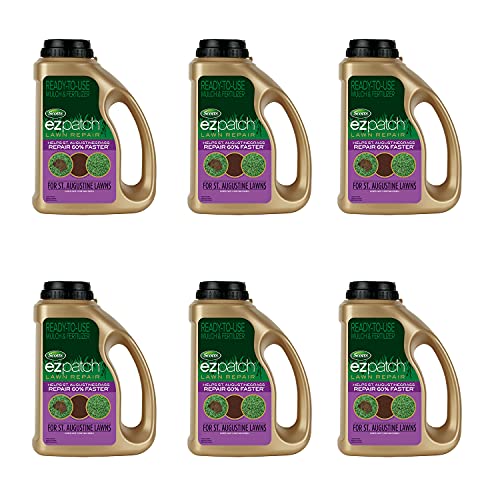
Scotts EZ Patch Lawn Repair for St. Augustine Lawns is a combination of mulch and fertilizer that can help repair your lawn in a quick and efficient manner. With its advanced formula, this product can repair St. Augustinegrass up to 60% faster than untreated controls, with visible results as early as 15 days after application (results may vary).
The mulch in this lawn repair mix is specially designed to absorb up to 6 times its weight in water, allowing it to expand and surround the seed in a moist and protective layer. This helps to create optimal conditions for seed growth and establishment.
The fertilizer in Scotts EZ Patch Lawn Repair for St. Augustine Lawns is formulated with exclusive controlled-release technology that feeds the grass over time, promoting healthy growth and establishment of St. Augustinegrass.
This ready-to-use lawn repair mix can cover up to 85 sq. ft., making it an ideal solution for small to medium-sized lawn repairs. Plus, it does not contain grass seed, making it a great option for those who want to repair their lawn without adding new grass.
8. Organic Fungicide Spray For Lawn & Garden.
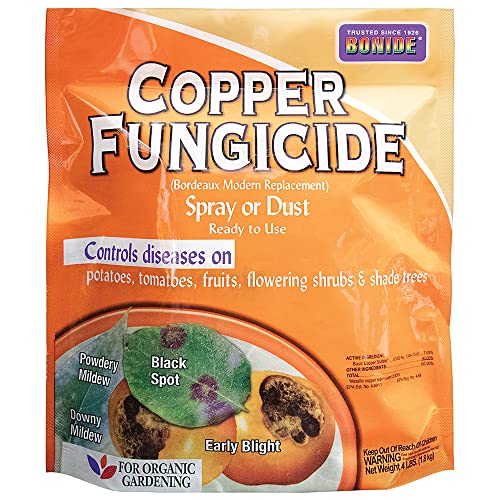
The Bonide Copper Fungicide Spray or Dust is a reliable solution for controlling and preventing common fungal diseases in your home garden. This product is a modern replacement for Bordeaux and is formulated to combat blight, leaf spot, scab, powdery mildew, peach leaf curl, and other related diseases.
You can easily apply this Copper Fungicide to a variety of plants in your home garden, including fruits, vegetables, beans, shrubs, flowers, and more. It is approved for organic gardening and is suitable for the production of organic produce. Additionally, it can be used up until the day of harvest, making it a convenient and effective solution.
The Bonide Copper Fungicide arrives conveniently ready-to-use, making it easy to apply. You can apply it to affected plants as a dust or mix it with water to apply as a spray. Please refer to the product label for full use instructions.
This product is reliable and efficient in controlling and preventing common fungal diseases in your home garden. With its organic gardening approval and ability to be used up until the day of harvest, you can rest assured that your produce is healthy and safe for consumption. Give your home garden the protection it deserves with Bonide Copper Fungicide Spray or Dust.
9. Heritage G Fungicide 30 Lb Bag (1 Bag) 6666273
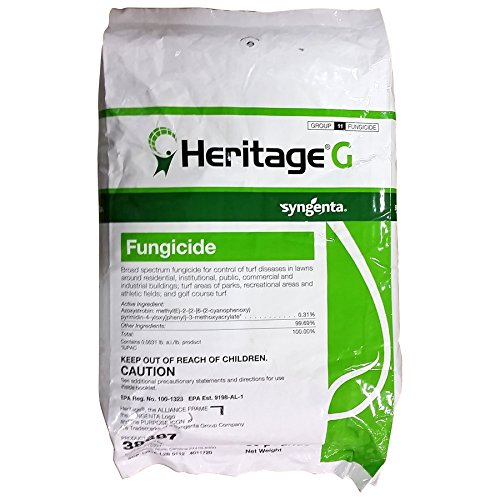
The Azoxystrobin 0.31% is a highly effective fungicide designed for use on golf courses, lawns, and various landscape areas. This product is suitable for use around residential, institutional, public, commercial, and industrial buildings, as well as parks, recreational areas, and athletic fields.
The active ingredient in this fungicide is Azoxystrobin, a broad-spectrum fungicide that offers long-lasting protection against a variety of common turf diseases. The 0.31% concentration of Azoxystrobin in this product ensures that it is both powerful and effective.
This fungicide is easy to use and can be applied using a variety of different methods, including spray applications and granular formulations. It is also highly versatile, making it suitable for use on a wide range of turf types, including cool-season grasses, warm-season grasses, and ornamental turf.
In addition to its impressive fungicidal properties, the Azoxystrobin 0.31% is also highly compatible with other turf care products and can be used as part of an integrated pest management program. Its low toxicity and environmental impact make it an ideal choice for those looking for an effective and sustainable fungicide solution.
Best Fungicide For St Augustine Grass FAQs
Are there any fungicides that are safe to use on St. Augustine grass during the summer months?
Yes, there are fungicides that are specifically designed to be safe for St. Augustine grass during the summer months. One of the most popular options is azoxystrobin, which is sold under various brand names. This fungicide is effective against a variety of common lawn diseases, including brown patch and dollar spot, and it is safe to use on St. Augustine grass even during periods of high heat and humidity.
Another option is propiconazole, which is also sold under various brand names. Like azoxystrobin, this fungicide is effective against a range of lawn diseases and is safe for use on St. Augustine grass during the summer months. In general, it is important to read and follow the label instructions carefully when using any fungicide on your lawn, and to avoid over-application or using multiple products at once.
If you are unsure about which fungicide to use or how to properly apply it to your St. Augustine grass, it may be a good idea to consult with a lawn care professional or your local extension office for guidance.
Are there any natural or organic fungicides that are effective for treating St. Augustine grass diseases?
Yes, there are natural and organic fungicides that can effectively treat St. Augustine grass diseases. One such option is neem oil, which is derived from the neem tree and has antifungal properties. It can be mixed with water and sprayed onto the affected grass to control diseases like brown patch and gray leaf spot. Another natural option is compost tea, which contains beneficial microorganisms that can help suppress fungal growth in the soil. Additionally, baking soda can be mixed with water and sprayed onto grass to control fungal diseases like powdery mildew. It is important to note that natural and organic fungicides may not be as potent as chemical fungicides and may require more frequent applications. It is also important to properly diagnose the specific disease affecting the grass to ensure the most effective treatment. Ultimately, a combination of cultural practices like proper watering and mowing, along with natural or organic fungicides, can help keep St. Augustine grass healthy and disease-free.
Can I mix fungicides to increase their effectiveness on St. Augustine grass?
Mixing fungicides is not recommended as it can result in unfavorable outcomes. Fungicides are chemical substances that are formulated to control specific fungal diseases, and each fungicide has a unique mode of action and formulation. Mixing different fungicides together can lead to chemical reactions that can render them ineffective or even harmful to the turfgrass.
Additionally, using too many fungicides can also lead to the development of resistant fungal strains, which can further complicate disease management. It is best to rotate the use of different fungicides with different modes of action to prevent the development of resistance.
If you are experiencing persistent fungal diseases on your St. Augustine grass, it is best to consult a professional turfgrass manager who can advise on the best course of action and recommend appropriate fungicides for your specific situation.
Can using the wrong fungicide harm my St. Augustine grass?
Yes, using the wrong fungicide on St. Augustine grass can harm it. Fungicides are used to control and prevent fungal diseases, such as brown patch and gray leaf spot, which can damage St. Augustine grass. However, different types of fungicides target different fungal diseases, and some types of fungicides can be harmful to certain types of grass.
For example, St. Augustine grass is sensitive to fungicides that contain propiconazole, which is an active ingredient found in some broad-spectrum fungicides. Applying propiconazole-based fungicides to St. Augustine grass can cause yellowing, stunted growth, and even death of the grass.
Therefore, it is important to choose a fungicide that is labeled for use on St. Augustine grass and is specifically formulated to control the fungal disease that is affecting your grass. It is also important to follow the instructions on the label carefully and apply the fungicide at the recommended rate and frequency to avoid any harm to your St. Augustine grass.
How long does it take for a fungicide to start working on St. Augustine grass?
The time it takes for a fungicide to start working on St. Augustine grass depends on the specific fungicide being used and the severity of the fungal infection. Some fungicides may start working within a few hours, while others may take several days or even weeks to show noticeable results. In general, it is important to follow the manufacturer's instructions for the specific fungicide being used, as well as to apply the fungicide at the recommended rate and frequency. Additionally, it is important to identify the specific type of fungal infection affecting the St. Augustine grass, as different fungicides may be more effective against different types of fungi. It is recommended to consult with a professional or a local extension office for guidance on identifying and treating fungal infections in St. Augustine grass.
How often should I apply fungicide to my St. Augustine grass to prevent fungal disease?
The frequency of applying fungicide to St. Augustine grass depends on various factors such as the type of fungicide, the severity of the fungal disease, and the weather conditions in your region. It is generally recommended to apply fungicide to prevent fungal diseases before the onset of the disease or at the first sign of symptoms.
For preventive measures, you can apply fungicide to St. Augustine grass every 21-28 days during the growing season. However, if the weather is hot and humid, you may need to apply the fungicide more frequently, such as every 14-21 days. It is essential to follow the instructions on the label of the fungicide product carefully to ensure that you apply the correct amount and at the right time.
Keep in mind that fungicides should be used as a part of an overall lawn care plan that includes proper watering, fertilizing, and mowing practices. Moreover, it is crucial to identify the type of fungal disease affecting your St. Augustine grass before applying fungicide, as some diseases may require different types of fungicides.
What are the most effective fungicides for treating St. Augustine grass diseases?
There are several fungicides available in the market that can be used to treat St. Augustine grass diseases. However, the effectiveness of a fungicide depends on the type of disease you are dealing with. The most common St. Augustine grass diseases include brown patch, gray leaf spot, and take-all root rot.
For brown patch, the most effective fungicides are azoxystrobin, propiconazole, and myclobutanil. These fungicides work by inhibiting fungal growth and preventing the spread of the disease.
For gray leaf spot, the most effective fungicides are azoxystrobin, propiconazole, and triadimefon. These fungicides work by preventing the growth and spread of the fungus.
For take-all root rot, the most effective fungicides are azoxystrobin, propiconazole, and flutolanil. These fungicides work by preventing the growth of the fungus in the roots.
It is important to note that fungicides should be used as a part of an integrated pest management program that includes proper cultural practices such as mowing, watering, and fertilization. It is also recommended to consult with a professional before applying any fungicides to ensure that they are used properly and effectively.
What fungicide should I use for treating gray leaf spot in St. Augustine grass?
Gray leaf spot is a common fungal disease that affects St. Augustine grass. To effectively treat this disease, you need to use the right fungicide. The most effective fungicides for treating gray leaf spot in St. Augustine grass are azoxystrobin, propiconazole, and flutriafol. These fungicides are systemic and protect the grass from the inside out.
When selecting a fungicide, it's essential to consider the severity of the disease and the size of the affected area. For small areas, you can use a ready-to-use fungicide that can be applied directly to the affected area. However, for larger areas, it's best to use a concentrated fungicide that can be mixed with water and applied using a sprayer.
It's also important to follow the instructions on the fungicide label carefully. Apply the fungicide at the recommended rate and frequency to ensure that you get the best results. Additionally, you should avoid applying fungicides during periods of high temperature or drought, as this can cause damage to the grass.
What is the best time of day to apply fungicide to St. Augustine grass?
The best time of day to apply fungicide to St. Augustine grass is in the early morning hours, shortly after the dew has dried. This is because the cooler temperatures and higher humidity levels during the early morning hours create an optimal environment for fungal growth, making it the ideal time to apply fungicide. Additionally, applying fungicide in the early morning allows for the product to dry before the heat of the day sets in, reducing the risk of the product evaporating or being washed away by rain or irrigation. It is important to carefully follow the instructions on the fungicide label and to wear protective clothing and equipment when applying the product. It is also recommended to regularly monitor the health of the St. Augustine grass and to consult with a professional if persistent fungal issues arise.
Which fungicide is best for controlling brown patch in St. Augustine grass?
When it comes to controlling brown patch in St. Augustine grass, there are several fungicides available, but the choice of the best one depends on various factors. Firstly, you need to make sure that you are using a fungicide that is specifically designed for St. Augustine grass. Secondly, you should consider the severity of the brown patch and the stage of the disease. Some of the commonly used fungicides for controlling brown patch in St. Augustine grass include azoxystrobin, propiconazole, and myclobutanil. These fungicides work by inhibiting the growth of the fungus that causes the disease. However, it is important to note that fungicides should be used as a part of an integrated pest management program, which includes cultural practices such as proper watering, mowing, and fertilization. Moreover, you should always read the label instructions carefully before using any fungicide and follow the recommended application rates and timing. It is also advisable to consult with a licensed professional for a proper diagnosis and treatment plan.

